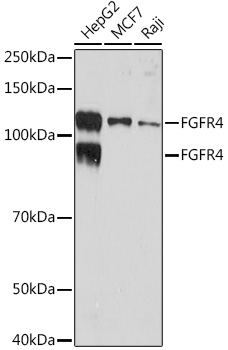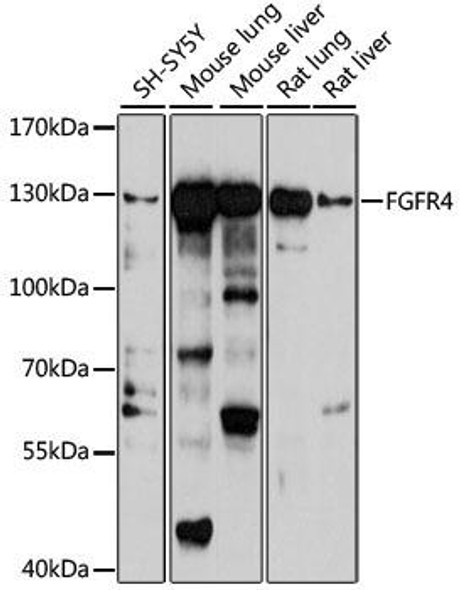Anti-FGFR4 Antibody (CAB9197)
- SKU:
- CAB9197
- Product type:
- Antibody
- Reactivity:
- Human
- Mouse
- Host Species:
- Rabbit
- Isotype:
- IgG
- Antibody Type:
- Monoclonal Antibody
- Research Area:
- Cell Biology
Description
| Antibody Name: | Anti-FGFR4 Antibody |
| Antibody SKU: | CAB9197 |
| Antibody Size: | 20uL, 50uL, 100uL |
| Application: | WB IHC |
| Reactivity: | Human, Mouse |
| Host Species: | Rabbit |
| Immunogen: | A synthesized peptide derived from human FGFR4 |
| Application: | WB IHC |
| Recommended Dilution: | WB 1:500 - 1:2000 IHC 1:50 - 1:200 |
| Reactivity: | Human, Mouse |
| Positive Samples: | HepG2, MCF7, Raji, Mouse lung |
| Immunogen: | A synthesized peptide derived from human FGFR4 |
| Purification Method: | Affinity purification |
| Storage Buffer: | Store at -20°C. Avoid freeze / thaw cycles. Buffer: PBS with 0.02% sodium azide, 0.05% BSA, 50% glycerol, pH7.3. |
| Isotype: | IgG |
| Sequence: | Email for sequence |
| Gene ID: | 2264 |
| Uniprot: | P22455 |
| Cellular Location: | |
| Calculated MW: | 88kDa |
| Observed MW: | 95KDa/125KDa |
| Synonyms: | CD334, JTK2, TKF |
| Background: | The protein encoded by this gene is a member of the fibroblast growth factor receptor family, where amino acid sequence is highly conserved between members and throughout evolution. FGFR family members differ from one another in their ligand affinities and tissue distribution. A full-length representative protein would consist of an extracellular region, composed of three immunoglobulin-like domains, a single hydrophobic membrane-spanning segment and a cytoplasmic tyrosine kinase domain. The extracellular portion of the protein interacts with fibroblast growth factors, setting in motion a cascade of downstream signals, ultimately influencing mitogenesis and differentiation. The genomic organization of this gene, compared to members 1-3, encompasses 18 exons rather than 19 or 20. Although alternative splicing has been observed, there is no evidence that the C-terminal half of the IgIII domain of this protein varies between three alternate forms, as indicated for members 1-3. This particular family member preferentially binds acidic fibroblast growth factor and, although its specific function is unknown, it is overexpressed in gynecological tumor samples, suggesting a role in breast and ovarian tumorigenesis. [provided by RefSeq, Jul 2008] |
| UniProt Protein Function: | FGFR4: a tyrosine-kinase receptor that acts as cell-surface receptor for fibroblast growth factors and plays a role in the regulation of cell proliferation, differentiation and migration, and in regulation of lipid metabolism, bile acid biosynthesis, glucose uptake, vitamin D metabolism and phosphate homeostasis. Required for normal down-regulation of the expression of CYP7A1, the rate-limiting enzyme in bile acid synthesis, in response to FGF19. Phosphorylates PLCG1 and FRS2. Ligand binding leads to the activation of several signaling cascades. Activation of PLCG1 leads to the production of the cellular signaling molecules diacylglycerol and inositol 1,4,5-trisphosphate. Phosphorylation of FRS2 triggers recruitment of GRB2, GAB1, PIK3R1 and SOS1, and mediates activation of the MAP kinase and AKT signaling pathways. Promotes SRC-dependent phosphorylation of the matrix protease MMP14 and its lysosomal degradation. FGFR4 signaling is down-regulated by receptor internalization and degradation; MMP14 promotes internalization and degradation of FGFR4. Mutations that lead to constitutive kinase activation or impair normal FGFR4 inactivation lead to aberrant signaling. Two isoforms of the human protein are formed by alternative splicing. This description may include information from UniProtKB |
| UniProt Protein Details: | Protein type:Kinase, protein; EC 2.7.10.1; Protein kinase, tyrosine (receptor); Protein kinase, TK; Membrane protein, integral; TK group; FGFR family Chromosomal Location of Human Ortholog: 5q35.2 Cellular Component: cytoplasm; endoplasmic reticulum; endosome; extracellular region; Golgi apparatus; integral to plasma membrane; intercellular junction; nucleoplasm; plasma membrane; transport vesicle Molecular Function:ATP binding; fibroblast growth factor binding; fibroblast growth factor receptor activity; heparin binding; protein binding; protein-tyrosine kinase activity Biological Process: activation of MAPKK activity; axon guidance; cell migration; epidermal growth factor receptor signaling pathway; fibroblast growth factor receptor signaling pathway; glucose homeostasis; innate immune response; insulin receptor signaling pathway; MAPKKK cascade; nerve growth factor receptor signaling pathway; peptidyl-tyrosine phosphorylation; phosphate ion homeostasis; phosphoinositide-mediated signaling; positive regulation of cell proliferation; positive regulation of metalloenzyme activity; positive regulation of proteolysis; protein amino acid autophosphorylation; Ras protein signal transduction; regulation of lipid metabolic process; small GTPase mediated signal transduction; vascular endothelial growth factor receptor signaling pathway |
| NCBI Summary: | The protein encoded by this gene is a member of the fibroblast growth factor receptor family, where amino acid sequence is highly conserved between members and throughout evolution. FGFR family members differ from one another in their ligand affinities and tissue distribution. A full-length representative protein would consist of an extracellular region, composed of three immunoglobulin-like domains, a single hydrophobic membrane-spanning segment and a cytoplasmic tyrosine kinase domain. The extracellular portion of the protein interacts with fibroblast growth factors, setting in motion a cascade of downstream signals, ultimately influencing mitogenesis and differentiation. The genomic organization of this gene, compared to members 1-3, encompasses 18 exons rather than 19 or 20. Although alternative splicing has been observed, there is no evidence that the C-terminal half of the IgIII domain of this protein varies between three alternate forms, as indicated for members 1-3. This particular family member preferentially binds acidic fibroblast growth factor and, although its specific function is unknown, it is overexpressed in gynecological tumor samples, suggesting a role in breast and ovarian tumorigenesis. [provided by RefSeq, Jul 2008] |
| UniProt Code: | P22455 |
| NCBI GenInfo Identifier: | 13432140 |
| NCBI Gene ID: | 2264 |
| NCBI Accession: | P22455.2 |
| UniProt Secondary Accession: | P22455,O43785, Q14309, Q71TW8, Q8TDA0, Q96KE5, G3JVM2 G3JVM5, G3JVM7, G3JVM9, |
| UniProt Related Accession: | P22455,AAB25788 |
| Molecular Weight: | 64,640 Da |
| NCBI Full Name: | Fibroblast growth factor receptor 4 |
| NCBI Synonym Full Names: | fibroblast growth factor receptor 4 |
| NCBI Official Symbol: | FGFR4 |
| NCBI Official Synonym Symbols: | TKF; JTK2; CD334 |
| NCBI Protein Information: | fibroblast growth factor receptor 4 |
| UniProt Protein Name: | Fibroblast growth factor receptor 4 |
| UniProt Synonym Protein Names: | CD_antigen: CD334 |
| Protein Family: | Fibroblast growth factor receptor |
| UniProt Gene Name: | FGFR4 |
| UniProt Entry Name: | FGFR4_HUMAN |




